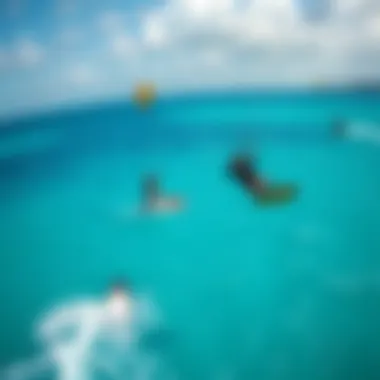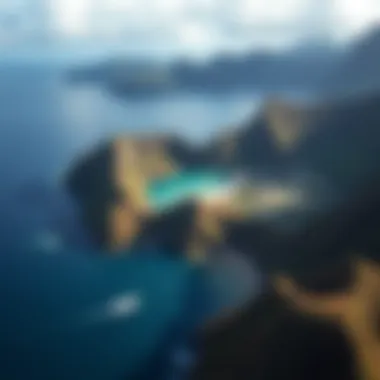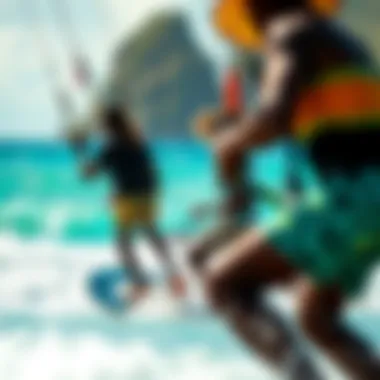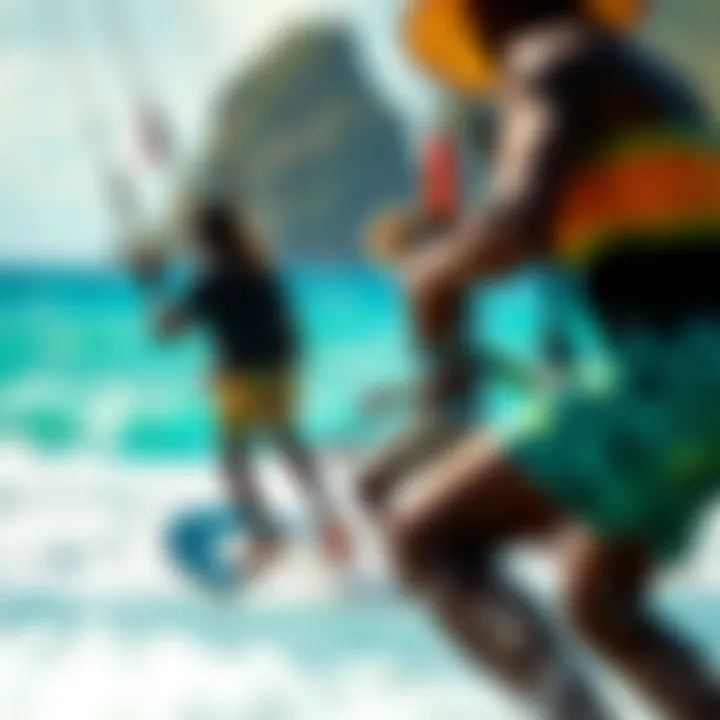Discovering the Wonders of Sea Bay, St. Lucia


Intro
Nestled within the picturesque landscape of St. Lucia, Sea Bay beckons with its stunning vistas and exciting outdoor activities. This hidden gem is not just another pretty coastline; it is a dynamic playground for kiteboarding enthusiasts and adventurers seeking thrill and beauty alike. The bay’s pristine waters and consistent winds create an ideal setting for both seasoned kiteboarders and those dipping their toes into the sport for the first time.
As we dive deeper into this guide, we’ll explore the many facets of Sea Bay. From the geographical features that shape the area to an examination of the local culture and community, this article provides a comprehensive look at everything Sea Bay has to offer. You'll discover the equipment you need, the techniques to master, and important safety practices that ensure every outing is both exhilarating and secure. Pack your boards and let’s embark on this journey to Sea Bay, where adventure meets the azure waves in a dance that is both captivating and rewarding.
Gear Insights
For kiteboarding, having the right gear can mean the difference between a memorable session and a frustrating one. Below, we delve into essential equipment tailored for various skill levels, ensuring you are well-equipped for your Sea Bay experience.
Latest Gear Reviews
In the realm of kiteboarding, technology evolves rapidly. 2023 has introduced some standout gear that deserves a closer look:
- Duotone Kiteboarding Evo: Known for its versatility, this kite performs exceptionally well in a variety of winds, making it a top choice for both novice and experienced riders. Its ability to handle gusty conditions makes it perfect for the wind patterns often found in Sea Bay.
- North Anthem: This kite balances performance with accessibility. It has an intuitive feel and allows for smooth landings and takeoffs, crucial for those still mastering their approach.
- Cabrinha, Switchblade: A favorite among advanced kiteboarders, this model offers impressive stability and powerful pop, ideal for executing tricks in the open waters of Sea Bay.
Essential Gear for Beginners
If you are new to kiteboarding, it's crucial to start with the basics. Here’s what you’ll need:
- Beginner Kite: Choose something with a lower aspect ratio for better control and stability.
- Harness: Opt for a comfortable and supportive harness that fits snugly.
- Control Bar: This is essential for steering and maneuvering your kite. Look for a bar that is easy to grip and suited for your kite's size.
- Board: A wider board provides better balance and is easier to ride, particularly in choppy waters.
- Safety Leash: Never underestimate the importance of a safety leash to ensure that you stay connected to your gear in the event of a wipeout.
"The right gear is your passport to an unforgettable adventure on the waves of Sea Bay. Choose wisely, and ride safely."
Techniques and Tips
Understanding how to control your kite and body is crucial in turning an ordinary session into an extraordinary one. Let’s break this down.
Advanced Tricks and Techniques
Once you feel comfortable with the basics, you might want to explore more sophisticated maneuvers:
- Jumping: Start with small hops, ensuring proper edging and kite control to maintain your flight.
- Backloop: As your confidence grows, try this exciting move. It requires timing the kite movements just right.
- Kiteloop: This requires experience but can add a thrilling twist to your session. Start practicing with the kite low to the water and build up your technique.
Safety Practices for Kiteboarders
Kiteboarding in Sea Bay can be exhilarating, but safety should always be a priority. Here are some essential tips:
- Know the Conditions: Before heading out, check the weather and wind conditions. Ideal wind speeds for beginners are 12 to 20 knots.
- Stay Clear of Obstacles: Be aware of your surroundings. Avoid areas with boats, swimmers, or rocky coastline.
- Use a Buddy System: It’s best to kite with others, especially when you’re new. This ensures there’s someone to help if any challenges arise.
- Wear a Helmet and Impact Vest: Protect yourself from potential falls and accidents on the water.
In summary, whether you’re packing your first kite for a weekend trip or heading out for an advanced session, knowing your gear and honing your skills are vital steps to truly enjoy Sea Bay's wonders. As you gear up, keep in mind the unique environment and vibrant local culture that enhance every moment spent here.
Geographical Overview of Sea Bay
Understanding the geographical elements of Sea Bay is critical not just for kiteboarding enthusiasts, but also for anyone looking to appreciate the rich diversity and unique offerings of this area. Sea Bay, located on the northern edge of St. Lucia, serves as a vibrant interface between land and sea, making it a key player in both local ecology and recreational activities.
Location and Topography
Nestled on the west coast, Sea Bay is enveloped by lush, verdant hills that inspire awe and invite exploration. The bay stretches about two kilometers, bordered by sandy beach on one side and rocky cliffs on the other, providing a picturesque setting that balmy tropical winds grace. This strategic location catches prevailing trade winds, making it ideal for not only kiteboarding but also for other water activities such as windsurfing and sailing.
A few notable high spots around the bay offer panoramic views. If you decide to hike up the surrounding hills, the sight of turquoise waters merging into the horizon is something that can’t just be glimpsed in pictures—it's a moment to be experienced in reality. While this area is serene, with soft waves rolling onto the shore, one should also be aware of the more rugged sections, which add character and challenge to any adventure. The topography here not only enhances the aesthetics but also affects wave patterns and currents, critical factors for those braving the waters.
Climate and Weather Patterns
St. Lucia enjoys a tropical climate, and Sea Bay is no exception. The area is typically warm year-round, with temperatures ranging between 24°C to 30°C (75°F to 86°F). The weather here largely hinges on two seasons: the dry season, stretching from December to May, and the wet season, which lasts from June to November.
For kiteboarders, the dry season is the sweet spot. Winds during this period blow consistently from the east, creating ideal conditions for riding the waves and harnessing the sky. However, the wet season—though it brings about occasional downpours—can still provide some great opportunities once storms pass. It’s not uncommon for locals to talk about how, after a rain, there’s an exhilarating rush in the air, as if nature is calling kiteboarders back onto the water.
While planning a trip to Sea Bay, it’s wise to take a closer look at seasonal forecasts. Weather patterns can shift rapidly in the tropics, and understanding local conditions is crucial. Relying on local information sources, such as government meteorological departments or local weather apps, can help navigate unexpected weather changes.
"Choosing to know the weather in advance does not just keep you dry; it keeps your kite in the air."
By comprehensively engaging with the geographical aspects of Sea Bay, one gains not only an appreciation of this beautiful locale but also a strategic advantage in planning activities that optimize the experience in this stunning part of St. Lucia.
Ecological Significance


The ecological importance of Sea Bay in St. Lucia extends far beyond its stunning vistas and inviting waters. This location is not just a paradise for kiteboarding enthusiasts; it plays a crucial role in maintaining ecological balance and supporting diverse life forms. A vibrant ecosystem nurtured by the bay contributes to the health of both marine and terrestrial environments, making it an area worth understanding in depth.
Biodiversity in and Around the Bay
The rich biodiversity of Sea Bay is one of its standout features. Here, the waters teem with a myriad of species, from colorful coral reefs that provide habitats for fish like parrotfish and butterflyfish, to seabirds that roam the skies above. You might also spot manatees or the occasional dolphin, making for breathtaking encounters.
Consider the seagrass beds that lie beneath the water's surface. These plants are not just beautiful; they serve as nurseries for juvenile fish and are crucial for carbon sequestration. With their ability to filter pollutants and stabilize the seafloor, they support a broader range of marine life, ensuring that the ecosystem remains healthy.
- The shorelines are often graced by mangroves, which provide shelter and breeding grounds for many coastal species.
- These forests play a key role in protecting against erosion and storm surges, highlighting their importance beyond mere aesthetics.
Biodiversity doesn’t just stop at the water’s edge; the terrestrial ecosystems surrounding Sea Bay also host various endemic plant species and wildlife. Many of these species are unique to St. Lucia, contributing to a rich cultural tapestry and indigenous knowledge surrounding the natural world.
Conservation Efforts and Challenges
While Sea Bay boasts an abundance of life, the balance is precarious. Conservation efforts in the region are vital to combat the pressures of tourism and climate change. Local organizations and governmental bodies work tirelessly to create protected marine areas aimed at preserving the delicate ecosystems.
Some key conservation strategies include:
- Education and Awareness: Informing locals and visitors about the sensitive nature of the bay's ecosystems encourages responsible behavior. Just knowing that the coral structures can take decades to thrive helps people appreciate the underwater world more deeply.
- Sustainable Practices: Kiteboarding is encouraged in designated spots to minimize ecological disruption. This kind of thoughtfulness ensures that both thrill-seekers and nature continue to coexist harmoniously.
However, challenges abound. Issues like pollution, overfishing, and unauthorized access to sensitive areas threaten the ecosystems. Collaborations among local communities, environmentalists, and policymakers are essential in developing resilience against these pressures. The commitment to sustainable practices often comes from those who live and breathe the surroundings, as their insights can guide efforts to protect what they hold dear.
"The health of Sea Bay's ecosystems reflects our actions. Protecting them means preserving our way of life and those who come after us."
Cultural Context
Understanding the cultural context of Sea Bay in St. Lucia is significant for various reasons, particularly for kiteboarders, travelers, and enthusiasts who aim to appreciate the fullness of the area. The culture of a place reflects its historical influences, community dynamics, and local traditions, all of which contribute to the unique flavor of the destination. By grasping these elements, visitors can deepen their engagement with the environment and foster meaningful connections with the community.
Historical Background of St. Lucia
St. Lucia has a rich history that is painted with the hues of colonial struggles, indigenous heritage, and cultural amalgamation. Known for its stunning landscapes and picturesque bays, the island was claimed by the French and British during the era of colonization. The ongoing tug-of-war between these two colonial powers lasted for centuries, leading to diverse cultural impacts on local society.
The indigenous Arawak and Carib peoples initially inhabited the island, but by the 16th century, European colonists began to settle. The island changed hands multiple times, with over fourteen different occupations, leading to a blend of French and British influences that can still be seen today. For instance, the predominantly Creole culture is a reminder of the mixed heritage, where vibrant festivals, music, and the local dialect draw from both British and French legacies.
This historical backdrop lays the groundwork for the community’s current identity and ways. Kiteboarders visiting Sea Bay might not only enjoy the adrenaline rush of riding the waves but also appreciate the deep-seated traditions that underpin the island’s rich cultural tapestry.
Local Traditions and Culinary Influences
In St. Lucia, local traditions echo through every aspect of life, from music and dance to the culinary landscape. The island is renowned for its lively festivals, such as Jounen Kweyol, which celebrates the local Creole culture. Such events often feature traditional food, Creole music, and elaborate costumes, offering visitors a taste of the island’s vibrant spirit.
When it comes to cuisine, St. Lucian food is a true representation of its diverse heritage. Dishes often combine elements from African, French, and Caribbean cuisines, leading to flavors that are rich and robust. Fish broth, callaloo soup, and green fig and saltfish are just a few examples that kiteboarders might try after a day on the water.
The use of fresh, local ingredients makes the culinary experience exceptional. Markets in nearby towns buzz with activity, where local vendors sell fruits, spices, and handcrafted goods. Engaging with these vendors provides an insight into daily life and fosters connections that enhance the travel experience.
Throughout Sea Bay, cultural influences manifest in simple yet profound ways - whether it’s the rhythm of local music that could easily find its way to your heart or the taste of a homemade delicacy that invites you back for seconds. Appreciating these layers allows adventurers to grasp the essence of St. Lucia, not just as a kiteboarding destination, but as a community steeped in history and rich traditions.
"To understand a place, you don't just look at its landscape; you listen to its stories and taste its food."
As kiteboarders, instructors, and hobbyists flock to Sea Bay, they can leave with plenty of wind beneath their wings, having not just surfed its waters but danced through its cultures.
Kiteboarding Opportunities
Kiteboarding around Sea Bay in St. Lucia presents a blend of thrill and nature’s beauty that captures the essence of adventure. This beloved water sport has found a sweet spot in the hearts of both locals and visitors, offering experiences that vary from relaxing leisure to heart-pumping excitement. Understanding the offerings in this region not only highlights the joy of kiteboarding but also sheds light on the surrounding community and its commitment to fostering a culture of sportsmanship and environmental awareness.
Ideal Conditions for Kiteboarding
The first thing on any kiteboarder’s radar is the conditions of the water, and Sea Bay does not disappoint. The waters here are typically warm and inviting, with temperatures averaging around 27°C (80°F) year-round. One of the standout features of this bay is its reliable wind patterns.
From December to July, the trade winds kick in, consistently blowing at 15 to 25 knots. This invigorating airflow creates the perfect setting for both novices and pros to take to the skies.
- Wind Direction: The north-east trade winds provide side-onshore conditions, ensuring a safe and enjoyable kiting experience.
- Water State: The bay's natural topography results in flat water areas nestled next to small waves, offering ideal spots for learning new tricks or simply cruising around.
Whether you are gearing up for your first attempt or going for an adrenaline-heavy jump, understanding these local wind and water conditions can significantly enhance your experience.
Local Schools and Hiring Equipment
For those unfamiliar with the intricacies of kiteboarding, several local schools dot the shoreline of Sea Bay. They cater to various skill levels, making it easy for anyone to dive into the sport. Here are a couple prominent institutions:


- Kite School St. Lucia: This school offers both group classes and private instruction. They focus on teaching safety and kite control, ensuring new enthusiasts start off on the right foot.
- Adventure Kitesurfing Academy: Known for their personalized training and extensive rental equipment, they are ideal for those looking to refine their skills or try kiteboarding for the first time.
When it comes to hiring equipment, there are multiple rental shops scattered near the beach.
- Safety First: Always ensure equipment is well-maintained and up-to-date. A ride on an outdated kite can turn a delightful escapade into a precarious one.
- Collecting Gear: Most rental services also provide packages that include boards, kites, and harnesses, making it easy to gear up without needing to haul bulky items from home.
Seasonal Considerations for Kiting
Kiteboarding in Sea Bay comes alive during specific seasons, directly influenced by weather and wind patterns.
- Peak Season (December to July): The winds are strong and steady, making it the best time for kiteboarding. The generally good weather attracts both local and international kiteboarders alike. Expect a vibrant atmosphere filled with camaraderie and friendly competition.
- Off-Peak Season (August to November): During these months, winds can tend to be lighter and less reliable. However, this can also mean quieter beaches, if you’re looking for a more serene experience. It's a great chance to work on fundamentals and enjoy the beauty of the bay without the hustle.
Kiteboarding enthusiasts often say that the best time on the water is not just about wind conditions but also about the sense of community formed over shared experiences.
Understanding these seasonal patterns will allow kiteboarders to maximize their time on the water and engage more deeply with the local environment. Engage with local clubs or social media groups to stay updated on local events or to catch word-of-mouth tips about the best days to ride the waves.
As you prepare to explore the kiteboarding opportunities in Sea Bay, keeping these elements in mind will pave the way for a thrilling and memorable experience.
Safety Protocols
Safety plays a pivotal role for those looking to enjoy the exhilarating experience of kiteboarding at Sea Bay in St. Lucia. As with any water activity, understanding the safety protocols is not just a recommendation—it's a necessity. Kiteboarding can be a thrilling adventure, full of speed and skill, yet it comes with its own set of risks. Adhering to safety guidelines helps mitigate these risks, ensuring that kiteboarders can fully immerse themselves in the waves without unnecessary concerns.
Understanding Local Regulations
Each locale has its unique set of regulations governing water sports, and St. Lucia is no different. Familiarity with local laws surrounding kiteboarding is crucial not only for compliance but also for the safety of oneself and others. For instance, there may be restricted zones to prevent kiting too close to swimmers or vessels. Additionally, understanding local weather patterns, which can shift rapidly, is essential.
Here’s a breakdown of key regulations that kiteboarders should keep in mind:
- Notices to mariners: Regularly check for updates regarding waterway navigation and safety announcements. Often, local authorities issue guidelines that are crucial for safe practice.
- Emergency contact numbers: Keep local emergency contacts handy. It is advisable to be aware of the nearest hospital or emergency services.
- Kiteboarding permits: In certain zones, you may require permits to kiteboard. Always inquire about this before heading out.
- Environmental protections: Respect areas that are designated as environmentally sensitive or protected to maintain the beauty and biodiversity of Sea Bay.
Staying informed and compliant with these regulations not only keeps kiteboarders safe but also fosters a harmonious relationship with the local community and environment.
Safety Gear Recommendations
Equipping oneself with adequate safety gear is non-negotiable for kiteboarders. The gear not only enhances performance but significantly increases safety during those high-speed maneuvers and unpredictable situations. Here are a few essentials:
- Personal Floatation Device (PFD): Always wear a PFD designed for water sports. It can save your life in emergencies.
- Safety Leash: This device connects the rider to the kite, allowing for quick release in case of emergencies, minimizing the risk of entanglement or loss of control.
- Helmet: A good-quality helmet protects against head injuries during falls or collisions.
- Impact Vest: This provides additional protection for your torso against impact with the water and increases visibility while on the water.
- Sunglasses and Sunscreen: Good shades and sun protection can prevent sunburn and reduce glare, keeping your eyes protected.
Investing in proper safety gear is as vital as mastering the technique itself. This additional level of protection allows riders to push their limits while simultaneously enjoying the ride.
Remember: Safety first, fun second!
Accessing Sea Bay
Accessing Sea Bay is crucial for anyone looking to truly experience its beauty and recreational opportunities, especially kiteboarding enthusiasts. It’s one thing to know about the stunning landscapes or the invigorating winds, but getting to the bay and finding your niche within it is a whole other kettle of fish. Understanding the transport options available and nearby accommodations can make or break your trip. Here, we’ll dive into the best ways to reach Sea Bay and where to lay your head after an adrenaline-fueled day.
Transport Options to the Bay
When it comes to transportation, Sea Bay is relatively easy to reach, but knowing your options helps make the journey smooth. Here, you have a few avenues to consider:
- Car Rentals: Renting a vehicle offers the flexibility to explore the wider island. Major agencies like Hertz or Budget have stations at the Hewanorra International Airport. Just make sure you’re comfortable with the left-hand traffic!
- Public Transport: Local buses run regularly from Castries to various points, including nearby areas. This is an economical choice for those unbothered by a few stops along the way.
- Taxis: While on the pricier side, taxis are a convenient option. Ensure you negotiate the fare beforehand to avoid any surprises by the end of the journey.
- Private Transfers: Many hotels offer shuttle services, often included in your package. This could save you the hassle of navigating local transport systems and gets you to Sea Bay directly.
Being aware of these options means you can plan effectively, ensuring you spend less time worrying about logistics and more time on the water.
Accommodations Near Sea Bay
Once you've made it to Sea Bay, you’ll want a cozy place to recharge after a day spent kiteboarding or soaking up the sun. There are numerous accommodation options in the vicinity, catering to different preferences and budgets:
- Luxury Resorts: For those looking to indulge, hotels such as Jade Mountain or the Sandals Grande St. Lucian provide an opulent experience with stunning views and high-end amenities.
- Mid-range Hotels: Places like the Bay Gardens Beach Resort offer comfort and great facilities without breaking the bank. These hotels usually have direct access to the beach and watersports equipment readily available.
- Guesthouses and B&Bs: For a more intimate feel, consider local guesthouses. These often provide cultural insights and a personalized touch. Options like Villa Morpheus let you immerse yourself in the local ambiance.
- Camping: For the adventurous type, explore nearby camping spots. Nothing beats the thrill of sleeping under the stars while being a heartbeat away from the surf.
Regardless of your choice, selecting accommodation that aligns with your priorities is essential, as it will enhance your overall experience.
"The journey is just as important as the destination, especially with the rhythm of the waves guiding your way."
By choosing your transport wisely and finding the right place to stay, you’re setting the stage for an exciting adventure at Sea Bay, where the winds blow your worries away.
Engaging with the Community


Engaging with the community when visiting Sea Bay is not just a pleasant pastime; it’s a pathway to truly experiencing the essence of St. Lucia. This beautiful bay isn't merely a location for recreational activities; it's woven into the fabric of local life. By fostering connections with residents, visitors can gain insights and appreciation for the cultural tapestry that surrounds the bay. The benefits are manifold. For one, it enriches your understanding of the traditions and lifestyle of the island, enhancing your overall experience.
Moreover, local engagement can lead to better kiteboarding practices, since residents often have intimate knowledge of the bay's conditions and surroundings. Sharing stories or tips with experienced kiteboarders can open doors to hidden spots and lesser-known tricks that lead to more exhilarating sessions on the water. Overall, investing time in community interactions nurtures a sense of belonging and respect, key components for any traveler looking to explore deeper.
Connecting with Local Kiteboarders
Building relationships with local kiteboarders is a cornerstone of enjoying Sea Bay to the fullest. These individuals often hold a wealth of information about kiteboarding spots that aren’t found in brochures or websites. Instead of rushing into the water without a clue, finding a local kiteboarding buddy could turn a basic outing into an unforgettable adventure.
- Exchange Knowledge: Local kiteboarders are familiar with the idiosyncrasies of the bay that can affect your time on the water. From wind patterns to tidal changes, these insights can drastically improve your kiteboarding experience.
- Find New Spots: Locals often know about secret launching spots or lesser-known areas that are perfect for either beginners or advanced riders, where fewer people are present.
- Camaraderie: There’s a strong sense of community among kiteboarders. Local kiteboarders often welcome newcomers, which can enhance your marketability as a kiteboarder and expand your social circle.
By connecting with these people, you not only improve your skills but also develop friendships that often extend beyond the water.
Participating in Local Events
Joining local events is another engaging way to immerse yourself in the vibrant culture of St. Lucia while kiteboarding at Sea Bay. The island regularly hosts various events that cater to both locals and visitors alike. Whether it's kiteboarding competitions, festivals celebrating local crafts and cuisine, or workshops focused on environmental awareness, there's always a happening you can dive into.
- Community Atmosphere: Attending such events gives travelers a chance to experience local customs and perhaps even partake in traditional celebrations. It fosters an understanding of how deeply sea activities are linked to local life.
- Networking Opportunities: These events can be a great opportunity to meet fellow kiteboarding enthusiasts, instructors, or even potential sponsors if you’re looking to advance your skills or career in the sport.
- Skill Acquisition: Workshops or demo days often organized around these events can provide you a chance to learn from experienced kiteboarders and instructors, which is invaluable whether you are a novice or seasoned rider.
Participating may even offer you the chance to contribute to community projects, thereby having an impact on conservation or local development initiatives while you enjoy everything the bay has to offer.
Engaging with the local community isn't just an option; it's a fundamental part of the enrichening experience every kiteboarder should seek when visiting Sea Bay.
For more information about local events and happenings, visit St Lucia Official Tourism or check local forums on Reddit.
When you take advantage of these opportunities, you create memories that last a lifetime while leaving a positive mark on the community that welcomes you.
Environmental Impact of Kiteboarding
The thrilling sport of kiteboarding brings with it a host of environmental considerations that deserve thorough examination. As kiteboarders carve through the waves of Sea Bay in St. Lucia, it's crucial to recognize not just the exhilaration of the sport but also its potential effects on the pristine ecosystem surrounding this idyllic location. Addressing the environmental impact of kiteboarding not only ensures the preservation of marine life but also enhances the overall kiteboarding experience for generations to come.
Kiteboarding can disturb local wildlife, particularly in fragile habitats and nesting areas. Many species rely on these coastal regions for food and shelter. Moreover, the impact of human activity increases the risk of pollution and degradation of natural spaces. Therefore, understanding sustainable practices is paramount to mitigate these impacts.
Sustainable Practices for Enthusiasts
For kiteboarders looking to enjoy the beautiful waters while being conscientious, several sustainable practices can be integral to preserving the environment. Here are a few vital approaches:
- Respect Designated Areas: Many regions have specific zones for kiteboarding to minimize disturbance to wildlife. Always pay attention to local signage.
- Leave No Trace: It’s essential to keep the beaches clean. Dispose of trash properly and carry out any waste generated during your outing.
- Eco-Friendly Gear: Consider using sustainable materials in your equipment. Some brands are developing kiteboarding gear that reduces environmental impact.
- Learn about Local Ecosystems: Gain an understanding of the flora and fauna native to Sea Bay. This knowledge can foster a deeper appreciation for the environment and promote responsible behaviors.
By adopting these sustainable practices, kiteboarders contribute positively to the ecological balance of Sea Bay, allowing both the sport and nature to thrive side by side.
Community-driven Conservation Initiatives
Community engagement is vital for the health of Sea Bay's environment. Local conservation initiatives play a key role in promoting sustainable practices among kiteboarders and the wider public. Here are some noteworthy examples:
- Beach Clean-Up Events: Engage with local organizations that host regular clean-up days, which help to remove debris from the shores and raise awareness about pollution.
- Wildlife Monitoring Programs: Participating in citizen science projects can help monitor local marine life, contributing valuable data to researchers and conservationists.
- Educational Workshops: These events often focus on the impacts of human activity on the environment, emphasizing how recreational users can lessen their footprints and encourage eco-friendly habits.
Engaging in these community-driven efforts not only benefits the environment but also fosters a sense of camaraderie among kiteboarders, helping build a culture of stewardship and responsibility.
"In the spirit of adventure, let us remember that our actions today craft the legacy of tomorrow's explorers."
Through proactive involvement in sustainable activities and local conservation efforts, kiteboarders can ensure that Sea Bay remains a vibrant and inviting destination for the years to come. This mutual respect between adventure and nature is essential for maintaining the allure of kiteboarding in such a breathtaking locale.
Future of Sea Bay and Kiteboarding
The potential evolution of Sea Bay as a notable hotspot for kiteboarding goes beyond the mere thrill of the gliding experience. Understanding this future opens up a pathway not only for enthusiasts but also for local communities and businesses. As kiteboarding gains popularity, various considerations shimmer on the horizon, pointing towards infrastructure enhancements, environmental sustainability, and community engagement. These elements are crucial for anyone considering making Sea Bay their playground or one of its corners their adventuring base.
Potential Developments in Infrastructure
As the interest in kiteboarding swells, so does the need for robust infrastructure to support this burgeoning activity. Enhancements are likely to start with the following key areas:
- Access Roads: Improving access roads to Sea Bay can facilitate easier travel for kiteboarders, tourists, and spectators alike, allowing for a smoother experience.
- Kiteboarding Centers: Establishing dedicated centers can provide a space for equipment rental, lessons, and social gatherings, fostering a stronger kiteboarding community.
- Safety Features: Adding safety gear stations, signage for local regulations, and emergency response teams can strengthen the safety net for both novices and seasoned riders.
These targeted developments can make the area more appealing and accessible, thus nurturing a flourishing water sports culture that benefits local businesses and attracts a diverse range of visitors.
Predicted Trends in Kiteboarding
As with most recreational activities, kiteboarding is not immune to trends that shape its practice. Keeping an eye on these trends can give kiteboarders a strategic edge in navigating Sea Bay's waters:
- Technical Evolution of Equipment: Advances in kite and board technology mean that the gear is becoming lighter, making it easier to perform tricks and enhance control, which in turn expands the variety of experiences on offer.
- Eco-conscious Practices: An increasing number of riders are becoming aware of their environmental footprint, leading to a demand for eco-friendly equipment and practices such as solar-powered kite centers or biodegradable materials in products.
- Diverse Skill Levels: More training programs catering to varying skill levels are sprouting up, making it easier for beginners to get into the sport while offering advanced techniques and tricks for seasoned boarders.
"As the winds of change blow through Sea Bay, kiteboarding will adapt not just for excitement, but for sustainability, forming a unique bond between enthusiasts and nature."
These trends not only signify the growth of the sport but also its potential for fostering a connection between adventurous spirits and the pristine environment of St. Lucia. Thus, as kiteboarding flourishes, Sea Bay is poised to transform into a beacon for thrill-seekers, while respecting the ecological essence it represents.















